Change Management, Employee Engagement, and Organizational Impact
VerifiedAdded on 2020/06/06
|18
|6458
|87
Report
AI Summary
This report provides a literature review on change management and its impact on employee engagement. It explores the terminology of change management, various theories and models such as Kotter's 8-Step Process and McKinsey's 7S model, and the advantages and disadvantages of change management. The report discusses the importance of employee engagement during organizational changes, highlighting the need for effective communication, strategic thinking, and the consideration of employee feelings and interests. It emphasizes the role of leadership in managing change, fostering employee participation, and creating a sense of urgency. The report also examines the significance of aligning business components and shared values to ensure smooth transitions. The report highlights the importance of strategic thinking and the use of models like SWOT and PESTLE analysis. This report is designed to help students understand and apply change management principles in real-world scenarios.
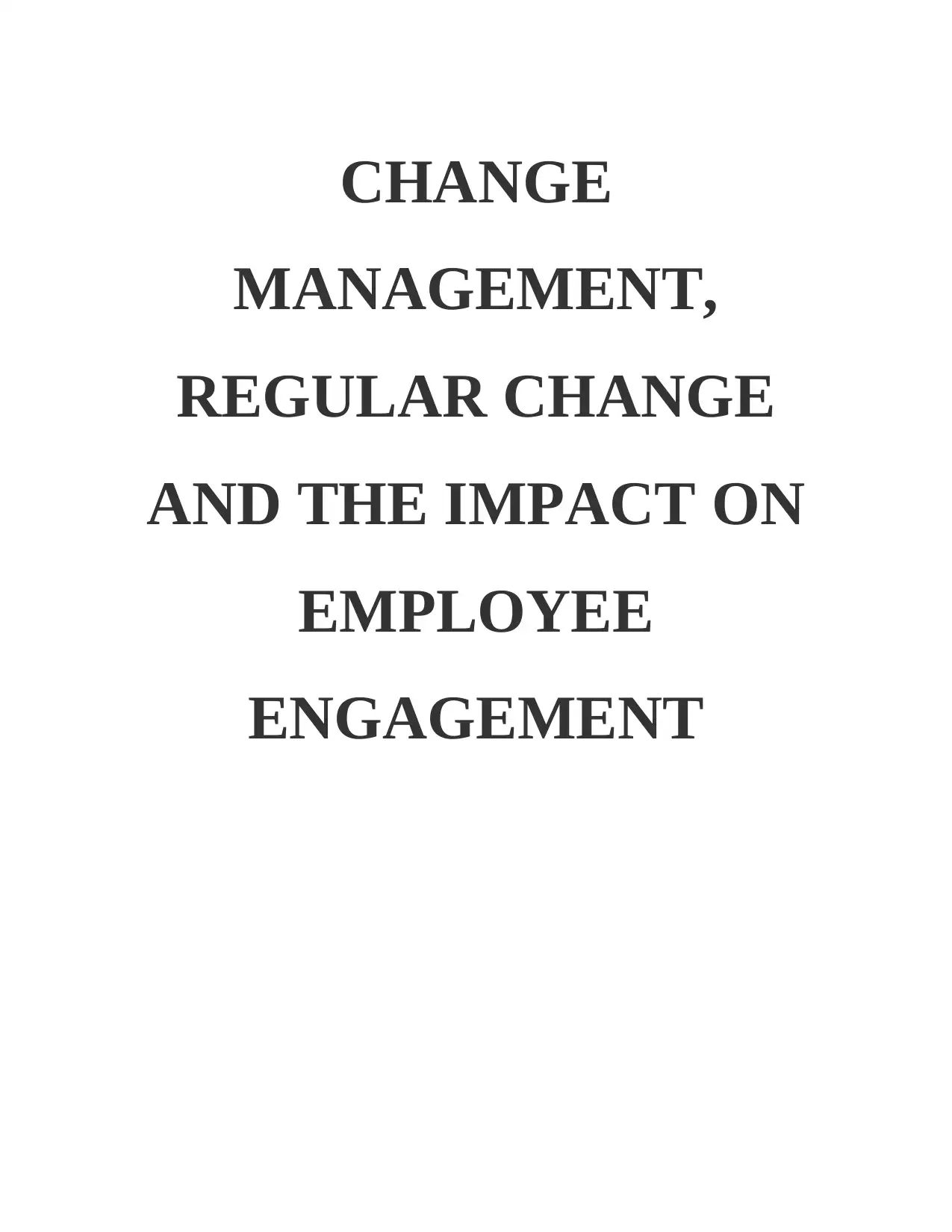
CHANGE
MANAGEMENT,
REGULAR CHANGE
AND THE IMPACT ON
EMPLOYEE
ENGAGEMENT
MANAGEMENT,
REGULAR CHANGE
AND THE IMPACT ON
EMPLOYEE
ENGAGEMENT
Paraphrase This Document
Need a fresh take? Get an instant paraphrase of this document with our AI Paraphraser
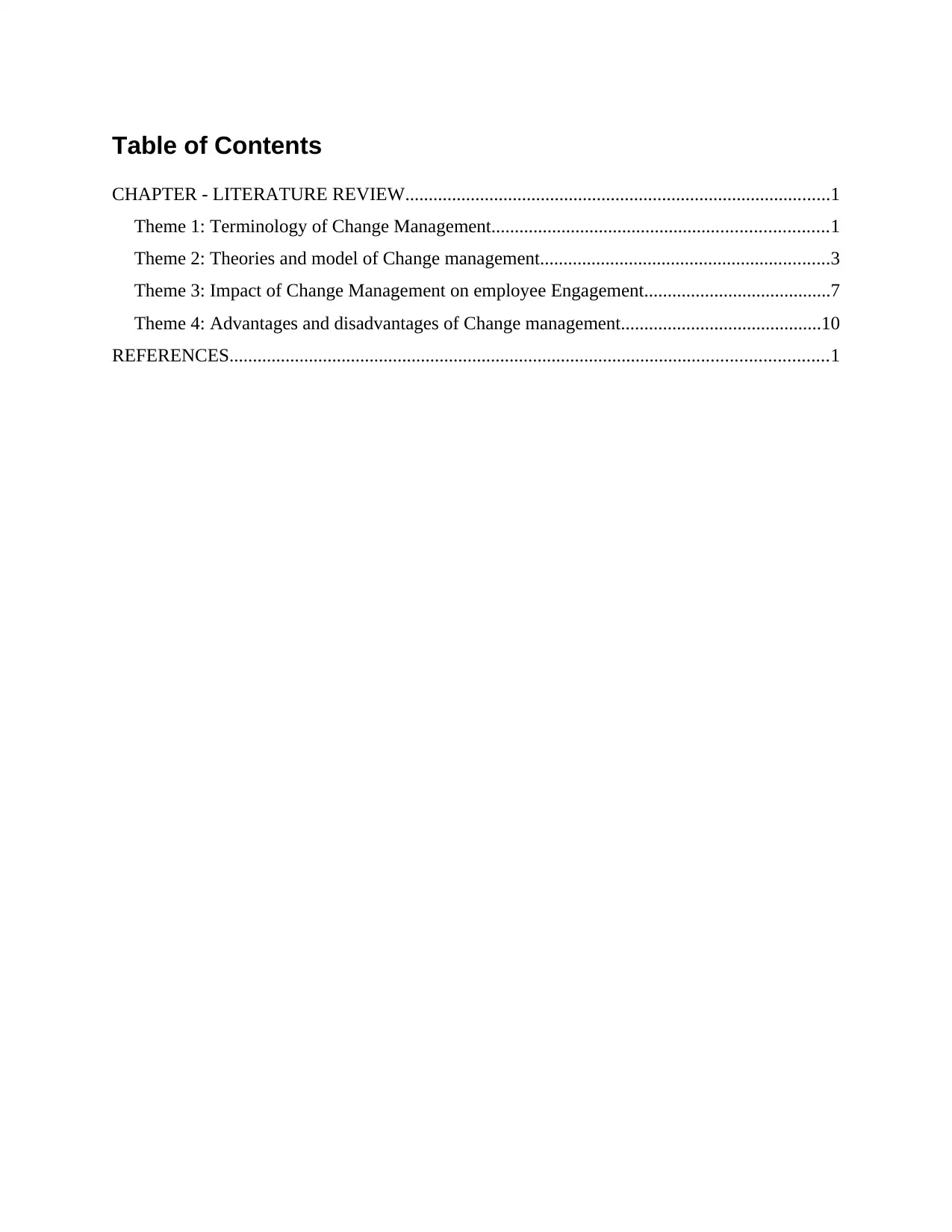
Table of Contents
CHAPTER - LITERATURE REVIEW...........................................................................................1
Theme 1: Terminology of Change Management........................................................................1
Theme 2: Theories and model of Change management..............................................................3
Theme 3: Impact of Change Management on employee Engagement........................................7
Theme 4: Advantages and disadvantages of Change management...........................................10
REFERENCES................................................................................................................................1
CHAPTER - LITERATURE REVIEW...........................................................................................1
Theme 1: Terminology of Change Management........................................................................1
Theme 2: Theories and model of Change management..............................................................3
Theme 3: Impact of Change Management on employee Engagement........................................7
Theme 4: Advantages and disadvantages of Change management...........................................10
REFERENCES................................................................................................................................1
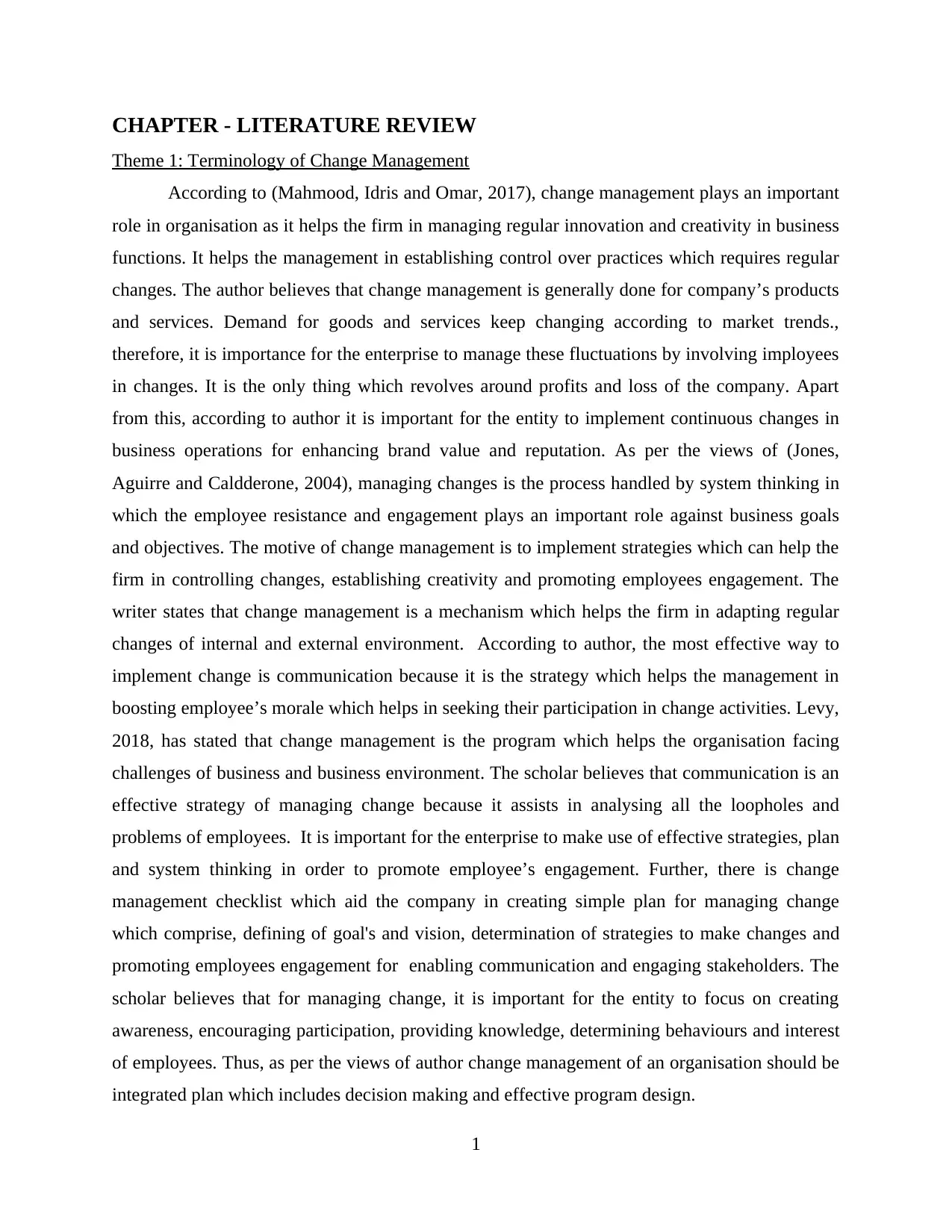
CHAPTER - LITERATURE REVIEW
Theme 1: Terminology of Change Management
According to (Mahmood, Idris and Omar, 2017), change management plays an important
role in organisation as it helps the firm in managing regular innovation and creativity in business
functions. It helps the management in establishing control over practices which requires regular
changes. The author believes that change management is generally done for company’s products
and services. Demand for goods and services keep changing according to market trends.,
therefore, it is importance for the enterprise to manage these fluctuations by involving imployees
in changes. It is the only thing which revolves around profits and loss of the company. Apart
from this, according to author it is important for the entity to implement continuous changes in
business operations for enhancing brand value and reputation. As per the views of (Jones,
Aguirre and Caldderone, 2004), managing changes is the process handled by system thinking in
which the employee resistance and engagement plays an important role against business goals
and objectives. The motive of change management is to implement strategies which can help the
firm in controlling changes, establishing creativity and promoting employees engagement. The
writer states that change management is a mechanism which helps the firm in adapting regular
changes of internal and external environment. According to author, the most effective way to
implement change is communication because it is the strategy which helps the management in
boosting employee’s morale which helps in seeking their participation in change activities. Levy,
2018, has stated that change management is the program which helps the organisation facing
challenges of business and business environment. The scholar believes that communication is an
effective strategy of managing change because it assists in analysing all the loopholes and
problems of employees. It is important for the enterprise to make use of effective strategies, plan
and system thinking in order to promote employee’s engagement. Further, there is change
management checklist which aid the company in creating simple plan for managing change
which comprise, defining of goal's and vision, determination of strategies to make changes and
promoting employees engagement for enabling communication and engaging stakeholders. The
scholar believes that for managing change, it is important for the entity to focus on creating
awareness, encouraging participation, providing knowledge, determining behaviours and interest
of employees. Thus, as per the views of author change management of an organisation should be
integrated plan which includes decision making and effective program design.
1
Theme 1: Terminology of Change Management
According to (Mahmood, Idris and Omar, 2017), change management plays an important
role in organisation as it helps the firm in managing regular innovation and creativity in business
functions. It helps the management in establishing control over practices which requires regular
changes. The author believes that change management is generally done for company’s products
and services. Demand for goods and services keep changing according to market trends.,
therefore, it is importance for the enterprise to manage these fluctuations by involving imployees
in changes. It is the only thing which revolves around profits and loss of the company. Apart
from this, according to author it is important for the entity to implement continuous changes in
business operations for enhancing brand value and reputation. As per the views of (Jones,
Aguirre and Caldderone, 2004), managing changes is the process handled by system thinking in
which the employee resistance and engagement plays an important role against business goals
and objectives. The motive of change management is to implement strategies which can help the
firm in controlling changes, establishing creativity and promoting employees engagement. The
writer states that change management is a mechanism which helps the firm in adapting regular
changes of internal and external environment. According to author, the most effective way to
implement change is communication because it is the strategy which helps the management in
boosting employee’s morale which helps in seeking their participation in change activities. Levy,
2018, has stated that change management is the program which helps the organisation facing
challenges of business and business environment. The scholar believes that communication is an
effective strategy of managing change because it assists in analysing all the loopholes and
problems of employees. It is important for the enterprise to make use of effective strategies, plan
and system thinking in order to promote employee’s engagement. Further, there is change
management checklist which aid the company in creating simple plan for managing change
which comprise, defining of goal's and vision, determination of strategies to make changes and
promoting employees engagement for enabling communication and engaging stakeholders. The
scholar believes that for managing change, it is important for the entity to focus on creating
awareness, encouraging participation, providing knowledge, determining behaviours and interest
of employees. Thus, as per the views of author change management of an organisation should be
integrated plan which includes decision making and effective program design.
1
⊘ This is a preview!⊘
Do you want full access?
Subscribe today to unlock all pages.

Trusted by 1+ million students worldwide
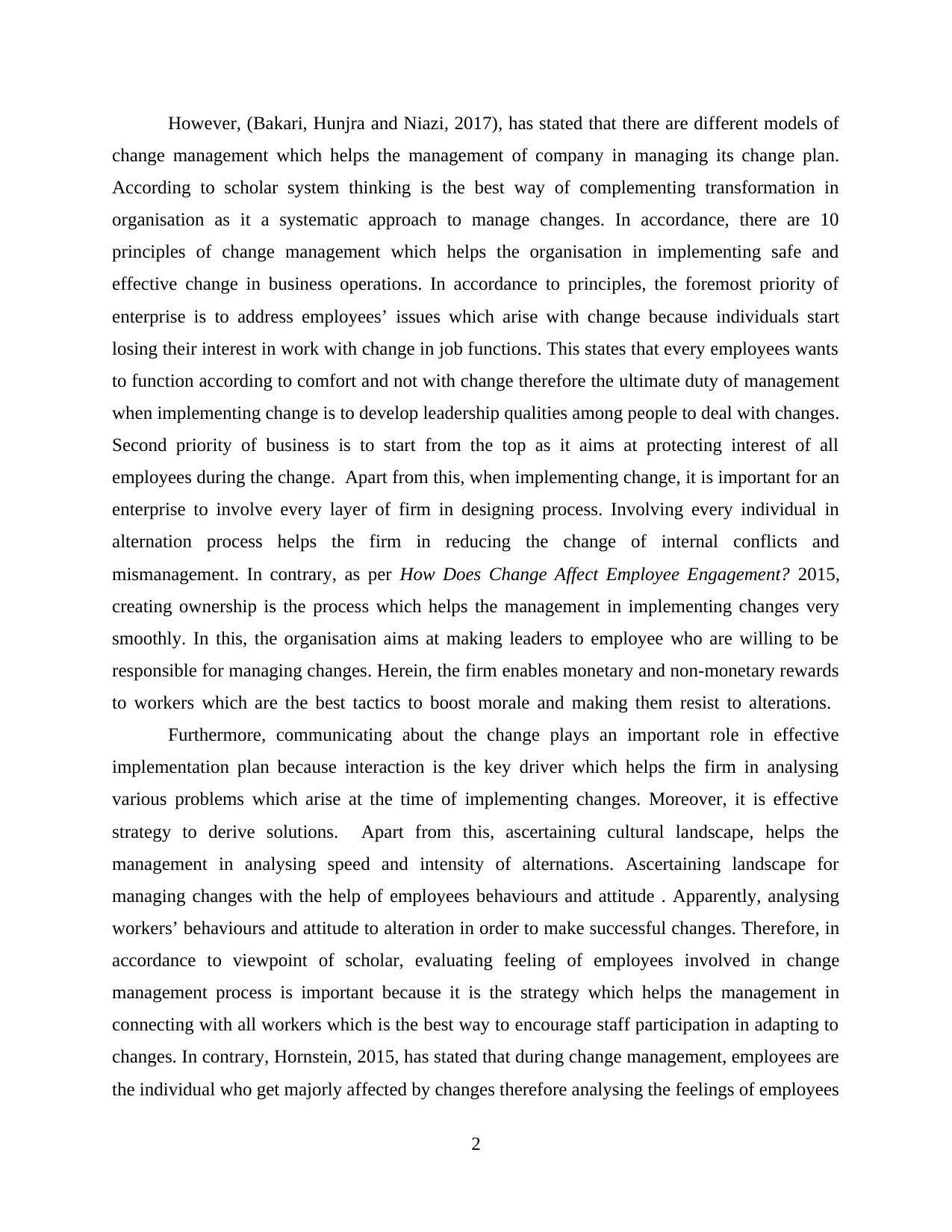
However, (Bakari, Hunjra and Niazi, 2017), has stated that there are different models of
change management which helps the management of company in managing its change plan.
According to scholar system thinking is the best way of complementing transformation in
organisation as it a systematic approach to manage changes. In accordance, there are 10
principles of change management which helps the organisation in implementing safe and
effective change in business operations. In accordance to principles, the foremost priority of
enterprise is to address employees’ issues which arise with change because individuals start
losing their interest in work with change in job functions. This states that every employees wants
to function according to comfort and not with change therefore the ultimate duty of management
when implementing change is to develop leadership qualities among people to deal with changes.
Second priority of business is to start from the top as it aims at protecting interest of all
employees during the change. Apart from this, when implementing change, it is important for an
enterprise to involve every layer of firm in designing process. Involving every individual in
alternation process helps the firm in reducing the change of internal conflicts and
mismanagement. In contrary, as per How Does Change Affect Employee Engagement? 2015,
creating ownership is the process which helps the management in implementing changes very
smoothly. In this, the organisation aims at making leaders to employee who are willing to be
responsible for managing changes. Herein, the firm enables monetary and non-monetary rewards
to workers which are the best tactics to boost morale and making them resist to alterations.
Furthermore, communicating about the change plays an important role in effective
implementation plan because interaction is the key driver which helps the firm in analysing
various problems which arise at the time of implementing changes. Moreover, it is effective
strategy to derive solutions. Apart from this, ascertaining cultural landscape, helps the
management in analysing speed and intensity of alternations. Ascertaining landscape for
managing changes with the help of employees behaviours and attitude . Apparently, analysing
workers’ behaviours and attitude to alteration in order to make successful changes. Therefore, in
accordance to viewpoint of scholar, evaluating feeling of employees involved in change
management process is important because it is the strategy which helps the management in
connecting with all workers which is the best way to encourage staff participation in adapting to
changes. In contrary, Hornstein, 2015, has stated that during change management, employees are
the individual who get majorly affected by changes therefore analysing the feelings of employees
2
change management which helps the management of company in managing its change plan.
According to scholar system thinking is the best way of complementing transformation in
organisation as it a systematic approach to manage changes. In accordance, there are 10
principles of change management which helps the organisation in implementing safe and
effective change in business operations. In accordance to principles, the foremost priority of
enterprise is to address employees’ issues which arise with change because individuals start
losing their interest in work with change in job functions. This states that every employees wants
to function according to comfort and not with change therefore the ultimate duty of management
when implementing change is to develop leadership qualities among people to deal with changes.
Second priority of business is to start from the top as it aims at protecting interest of all
employees during the change. Apart from this, when implementing change, it is important for an
enterprise to involve every layer of firm in designing process. Involving every individual in
alternation process helps the firm in reducing the change of internal conflicts and
mismanagement. In contrary, as per How Does Change Affect Employee Engagement? 2015,
creating ownership is the process which helps the management in implementing changes very
smoothly. In this, the organisation aims at making leaders to employee who are willing to be
responsible for managing changes. Herein, the firm enables monetary and non-monetary rewards
to workers which are the best tactics to boost morale and making them resist to alterations.
Furthermore, communicating about the change plays an important role in effective
implementation plan because interaction is the key driver which helps the firm in analysing
various problems which arise at the time of implementing changes. Moreover, it is effective
strategy to derive solutions. Apart from this, ascertaining cultural landscape, helps the
management in analysing speed and intensity of alternations. Ascertaining landscape for
managing changes with the help of employees behaviours and attitude . Apparently, analysing
workers’ behaviours and attitude to alteration in order to make successful changes. Therefore, in
accordance to viewpoint of scholar, evaluating feeling of employees involved in change
management process is important because it is the strategy which helps the management in
connecting with all workers which is the best way to encourage staff participation in adapting to
changes. In contrary, Hornstein, 2015, has stated that during change management, employees are
the individual who get majorly affected by changes therefore analysing the feelings of employees
2
Paraphrase This Document
Need a fresh take? Get an instant paraphrase of this document with our AI Paraphraser
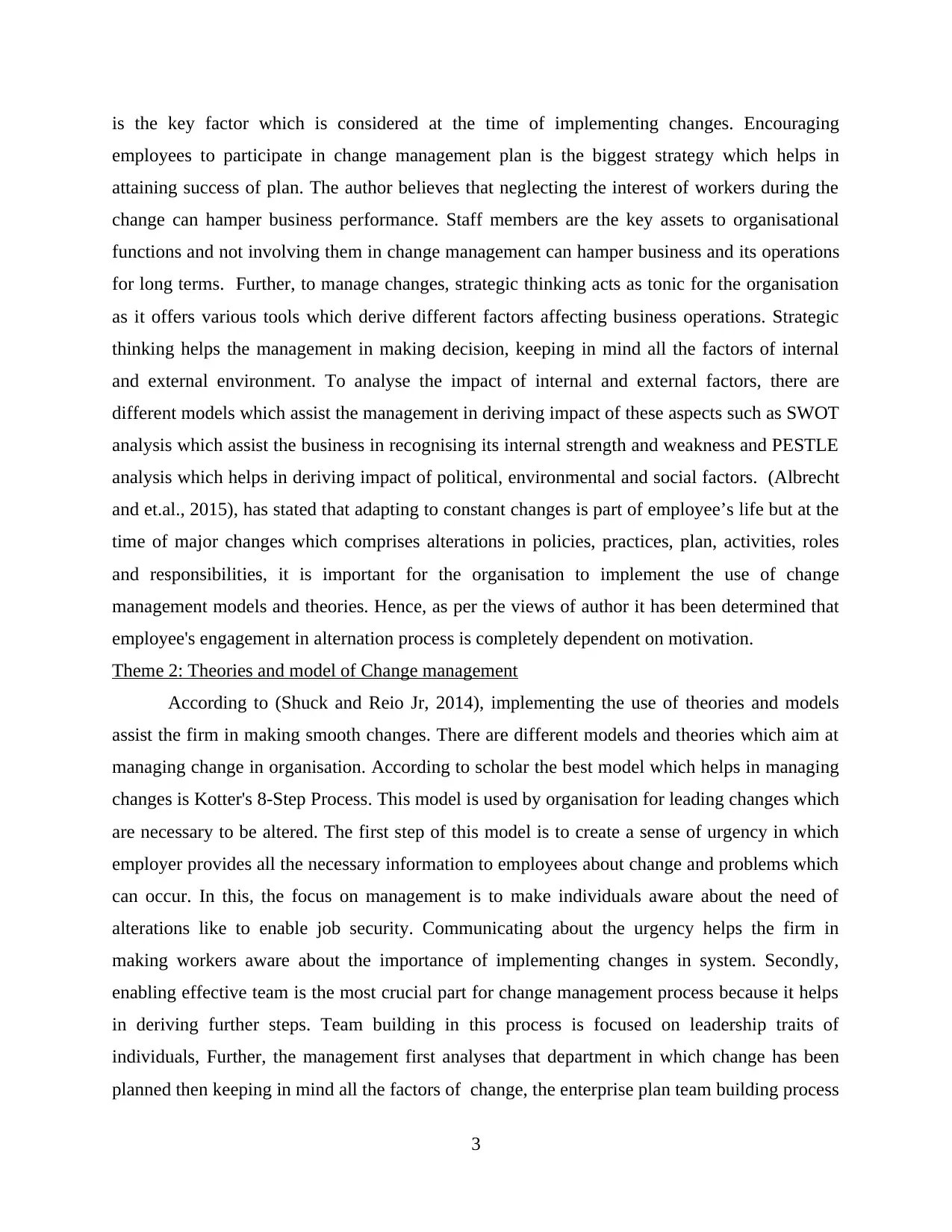
is the key factor which is considered at the time of implementing changes. Encouraging
employees to participate in change management plan is the biggest strategy which helps in
attaining success of plan. The author believes that neglecting the interest of workers during the
change can hamper business performance. Staff members are the key assets to organisational
functions and not involving them in change management can hamper business and its operations
for long terms. Further, to manage changes, strategic thinking acts as tonic for the organisation
as it offers various tools which derive different factors affecting business operations. Strategic
thinking helps the management in making decision, keeping in mind all the factors of internal
and external environment. To analyse the impact of internal and external factors, there are
different models which assist the management in deriving impact of these aspects such as SWOT
analysis which assist the business in recognising its internal strength and weakness and PESTLE
analysis which helps in deriving impact of political, environmental and social factors. (Albrecht
and et.al., 2015), has stated that adapting to constant changes is part of employee’s life but at the
time of major changes which comprises alterations in policies, practices, plan, activities, roles
and responsibilities, it is important for the organisation to implement the use of change
management models and theories. Hence, as per the views of author it has been determined that
employee's engagement in alternation process is completely dependent on motivation.
Theme 2: Theories and model of Change management
According to (Shuck and Reio Jr, 2014), implementing the use of theories and models
assist the firm in making smooth changes. There are different models and theories which aim at
managing change in organisation. According to scholar the best model which helps in managing
changes is Kotter's 8-Step Process. This model is used by organisation for leading changes which
are necessary to be altered. The first step of this model is to create a sense of urgency in which
employer provides all the necessary information to employees about change and problems which
can occur. In this, the focus on management is to make individuals aware about the need of
alterations like to enable job security. Communicating about the urgency helps the firm in
making workers aware about the importance of implementing changes in system. Secondly,
enabling effective team is the most crucial part for change management process because it helps
in deriving further steps. Team building in this process is focused on leadership traits of
individuals, Further, the management first analyses that department in which change has been
planned then keeping in mind all the factors of change, the enterprise plan team building process
3
employees to participate in change management plan is the biggest strategy which helps in
attaining success of plan. The author believes that neglecting the interest of workers during the
change can hamper business performance. Staff members are the key assets to organisational
functions and not involving them in change management can hamper business and its operations
for long terms. Further, to manage changes, strategic thinking acts as tonic for the organisation
as it offers various tools which derive different factors affecting business operations. Strategic
thinking helps the management in making decision, keeping in mind all the factors of internal
and external environment. To analyse the impact of internal and external factors, there are
different models which assist the management in deriving impact of these aspects such as SWOT
analysis which assist the business in recognising its internal strength and weakness and PESTLE
analysis which helps in deriving impact of political, environmental and social factors. (Albrecht
and et.al., 2015), has stated that adapting to constant changes is part of employee’s life but at the
time of major changes which comprises alterations in policies, practices, plan, activities, roles
and responsibilities, it is important for the organisation to implement the use of change
management models and theories. Hence, as per the views of author it has been determined that
employee's engagement in alternation process is completely dependent on motivation.
Theme 2: Theories and model of Change management
According to (Shuck and Reio Jr, 2014), implementing the use of theories and models
assist the firm in making smooth changes. There are different models and theories which aim at
managing change in organisation. According to scholar the best model which helps in managing
changes is Kotter's 8-Step Process. This model is used by organisation for leading changes which
are necessary to be altered. The first step of this model is to create a sense of urgency in which
employer provides all the necessary information to employees about change and problems which
can occur. In this, the focus on management is to make individuals aware about the need of
alterations like to enable job security. Communicating about the urgency helps the firm in
making workers aware about the importance of implementing changes in system. Secondly,
enabling effective team is the most crucial part for change management process because it helps
in deriving further steps. Team building in this process is focused on leadership traits of
individuals, Further, the management first analyses that department in which change has been
planned then keeping in mind all the factors of change, the enterprise plan team building process
3
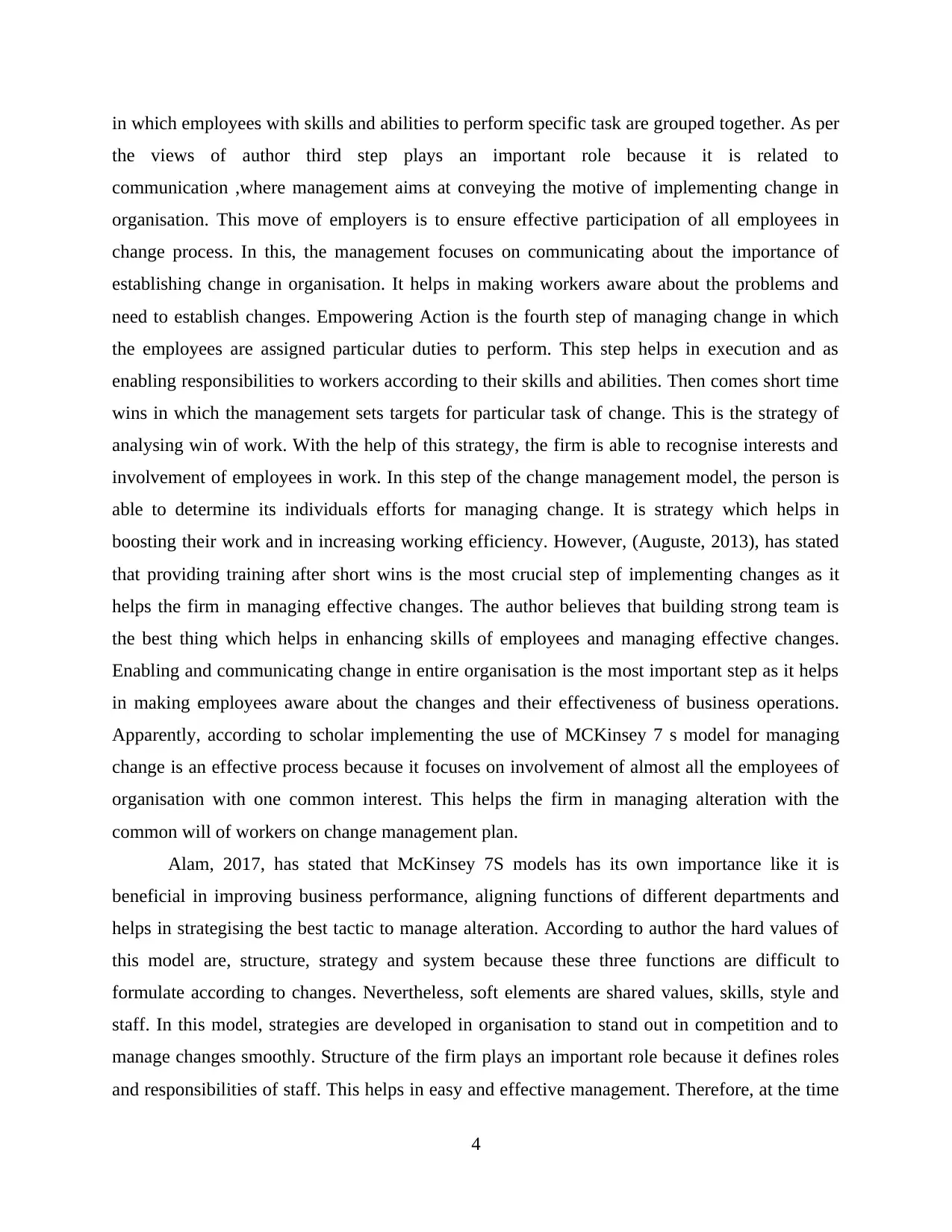
in which employees with skills and abilities to perform specific task are grouped together. As per
the views of author third step plays an important role because it is related to
communication ,where management aims at conveying the motive of implementing change in
organisation. This move of employers is to ensure effective participation of all employees in
change process. In this, the management focuses on communicating about the importance of
establishing change in organisation. It helps in making workers aware about the problems and
need to establish changes. Empowering Action is the fourth step of managing change in which
the employees are assigned particular duties to perform. This step helps in execution and as
enabling responsibilities to workers according to their skills and abilities. Then comes short time
wins in which the management sets targets for particular task of change. This is the strategy of
analysing win of work. With the help of this strategy, the firm is able to recognise interests and
involvement of employees in work. In this step of the change management model, the person is
able to determine its individuals efforts for managing change. It is strategy which helps in
boosting their work and in increasing working efficiency. However, (Auguste, 2013), has stated
that providing training after short wins is the most crucial step of implementing changes as it
helps the firm in managing effective changes. The author believes that building strong team is
the best thing which helps in enhancing skills of employees and managing effective changes.
Enabling and communicating change in entire organisation is the most important step as it helps
in making employees aware about the changes and their effectiveness of business operations.
Apparently, according to scholar implementing the use of MCKinsey 7 s model for managing
change is an effective process because it focuses on involvement of almost all the employees of
organisation with one common interest. This helps the firm in managing alteration with the
common will of workers on change management plan.
Alam, 2017, has stated that McKinsey 7S models has its own importance like it is
beneficial in improving business performance, aligning functions of different departments and
helps in strategising the best tactic to manage alteration. According to author the hard values of
this model are, structure, strategy and system because these three functions are difficult to
formulate according to changes. Nevertheless, soft elements are shared values, skills, style and
staff. In this model, strategies are developed in organisation to stand out in competition and to
manage changes smoothly. Structure of the firm plays an important role because it defines roles
and responsibilities of staff. This helps in easy and effective management. Therefore, at the time
4
the views of author third step plays an important role because it is related to
communication ,where management aims at conveying the motive of implementing change in
organisation. This move of employers is to ensure effective participation of all employees in
change process. In this, the management focuses on communicating about the importance of
establishing change in organisation. It helps in making workers aware about the problems and
need to establish changes. Empowering Action is the fourth step of managing change in which
the employees are assigned particular duties to perform. This step helps in execution and as
enabling responsibilities to workers according to their skills and abilities. Then comes short time
wins in which the management sets targets for particular task of change. This is the strategy of
analysing win of work. With the help of this strategy, the firm is able to recognise interests and
involvement of employees in work. In this step of the change management model, the person is
able to determine its individuals efforts for managing change. It is strategy which helps in
boosting their work and in increasing working efficiency. However, (Auguste, 2013), has stated
that providing training after short wins is the most crucial step of implementing changes as it
helps the firm in managing effective changes. The author believes that building strong team is
the best thing which helps in enhancing skills of employees and managing effective changes.
Enabling and communicating change in entire organisation is the most important step as it helps
in making employees aware about the changes and their effectiveness of business operations.
Apparently, according to scholar implementing the use of MCKinsey 7 s model for managing
change is an effective process because it focuses on involvement of almost all the employees of
organisation with one common interest. This helps the firm in managing alteration with the
common will of workers on change management plan.
Alam, 2017, has stated that McKinsey 7S models has its own importance like it is
beneficial in improving business performance, aligning functions of different departments and
helps in strategising the best tactic to manage alteration. According to author the hard values of
this model are, structure, strategy and system because these three functions are difficult to
formulate according to changes. Nevertheless, soft elements are shared values, skills, style and
staff. In this model, strategies are developed in organisation to stand out in competition and to
manage changes smoothly. Structure of the firm plays an important role because it defines roles
and responsibilities of staff. This helps in easy and effective management. Therefore, at the time
4
⊘ This is a preview!⊘
Do you want full access?
Subscribe today to unlock all pages.

Trusted by 1+ million students worldwide
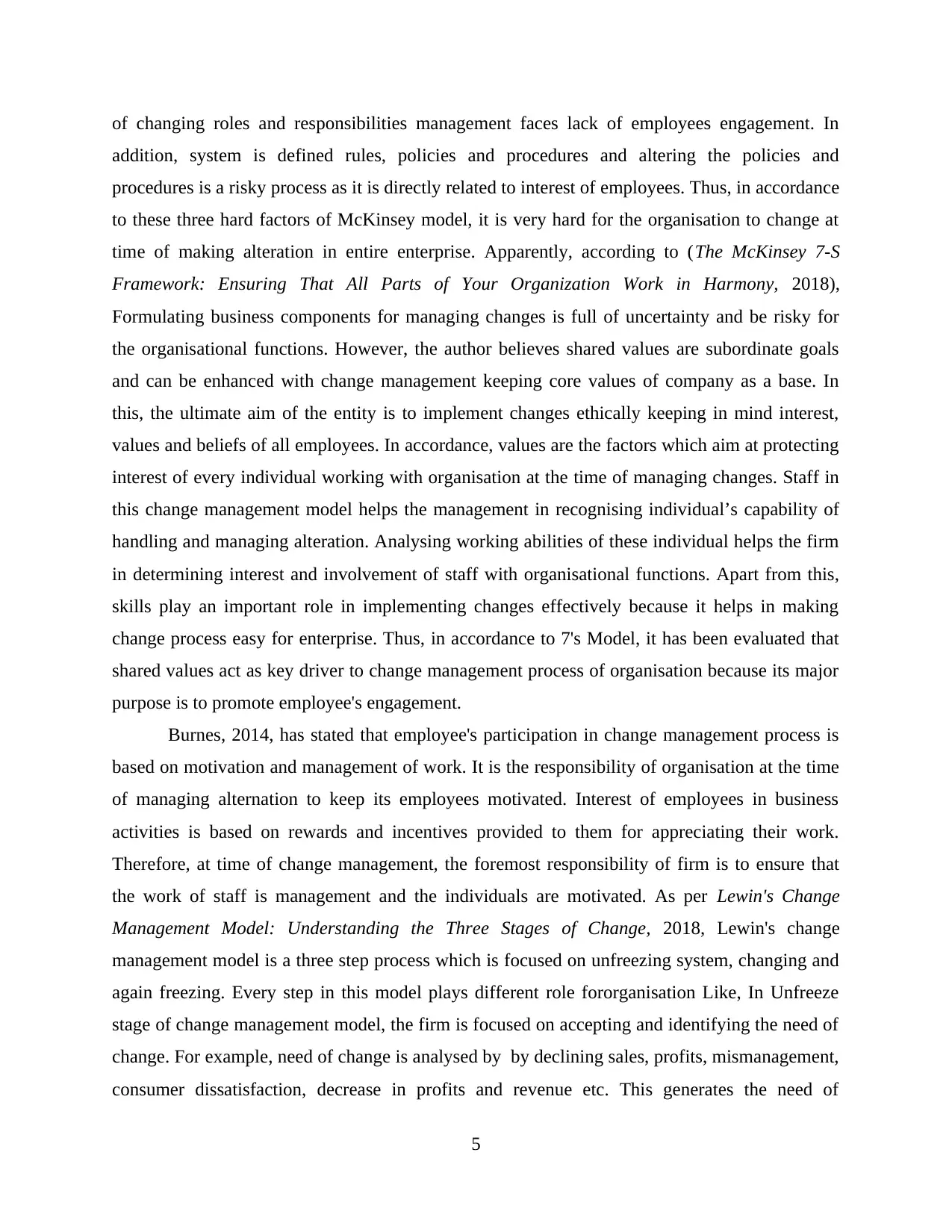
of changing roles and responsibilities management faces lack of employees engagement. In
addition, system is defined rules, policies and procedures and altering the policies and
procedures is a risky process as it is directly related to interest of employees. Thus, in accordance
to these three hard factors of McKinsey model, it is very hard for the organisation to change at
time of making alteration in entire enterprise. Apparently, according to (The McKinsey 7-S
Framework: Ensuring That All Parts of Your Organization Work in Harmony, 2018),
Formulating business components for managing changes is full of uncertainty and be risky for
the organisational functions. However, the author believes shared values are subordinate goals
and can be enhanced with change management keeping core values of company as a base. In
this, the ultimate aim of the entity is to implement changes ethically keeping in mind interest,
values and beliefs of all employees. In accordance, values are the factors which aim at protecting
interest of every individual working with organisation at the time of managing changes. Staff in
this change management model helps the management in recognising individual’s capability of
handling and managing alteration. Analysing working abilities of these individual helps the firm
in determining interest and involvement of staff with organisational functions. Apart from this,
skills play an important role in implementing changes effectively because it helps in making
change process easy for enterprise. Thus, in accordance to 7's Model, it has been evaluated that
shared values act as key driver to change management process of organisation because its major
purpose is to promote employee's engagement.
Burnes, 2014, has stated that employee's participation in change management process is
based on motivation and management of work. It is the responsibility of organisation at the time
of managing alternation to keep its employees motivated. Interest of employees in business
activities is based on rewards and incentives provided to them for appreciating their work.
Therefore, at time of change management, the foremost responsibility of firm is to ensure that
the work of staff is management and the individuals are motivated. As per Lewin's Change
Management Model: Understanding the Three Stages of Change, 2018, Lewin's change
management model is a three step process which is focused on unfreezing system, changing and
again freezing. Every step in this model plays different role fororganisation Like, In Unfreeze
stage of change management model, the firm is focused on accepting and identifying the need of
change. For example, need of change is analysed by by declining sales, profits, mismanagement,
consumer dissatisfaction, decrease in profits and revenue etc. This generates the need of
5
addition, system is defined rules, policies and procedures and altering the policies and
procedures is a risky process as it is directly related to interest of employees. Thus, in accordance
to these three hard factors of McKinsey model, it is very hard for the organisation to change at
time of making alteration in entire enterprise. Apparently, according to (The McKinsey 7-S
Framework: Ensuring That All Parts of Your Organization Work in Harmony, 2018),
Formulating business components for managing changes is full of uncertainty and be risky for
the organisational functions. However, the author believes shared values are subordinate goals
and can be enhanced with change management keeping core values of company as a base. In
this, the ultimate aim of the entity is to implement changes ethically keeping in mind interest,
values and beliefs of all employees. In accordance, values are the factors which aim at protecting
interest of every individual working with organisation at the time of managing changes. Staff in
this change management model helps the management in recognising individual’s capability of
handling and managing alteration. Analysing working abilities of these individual helps the firm
in determining interest and involvement of staff with organisational functions. Apart from this,
skills play an important role in implementing changes effectively because it helps in making
change process easy for enterprise. Thus, in accordance to 7's Model, it has been evaluated that
shared values act as key driver to change management process of organisation because its major
purpose is to promote employee's engagement.
Burnes, 2014, has stated that employee's participation in change management process is
based on motivation and management of work. It is the responsibility of organisation at the time
of managing alternation to keep its employees motivated. Interest of employees in business
activities is based on rewards and incentives provided to them for appreciating their work.
Therefore, at time of change management, the foremost responsibility of firm is to ensure that
the work of staff is management and the individuals are motivated. As per Lewin's Change
Management Model: Understanding the Three Stages of Change, 2018, Lewin's change
management model is a three step process which is focused on unfreezing system, changing and
again freezing. Every step in this model plays different role fororganisation Like, In Unfreeze
stage of change management model, the firm is focused on accepting and identifying the need of
change. For example, need of change is analysed by by declining sales, profits, mismanagement,
consumer dissatisfaction, decrease in profits and revenue etc. This generates the need of
5
Paraphrase This Document
Need a fresh take? Get an instant paraphrase of this document with our AI Paraphraser
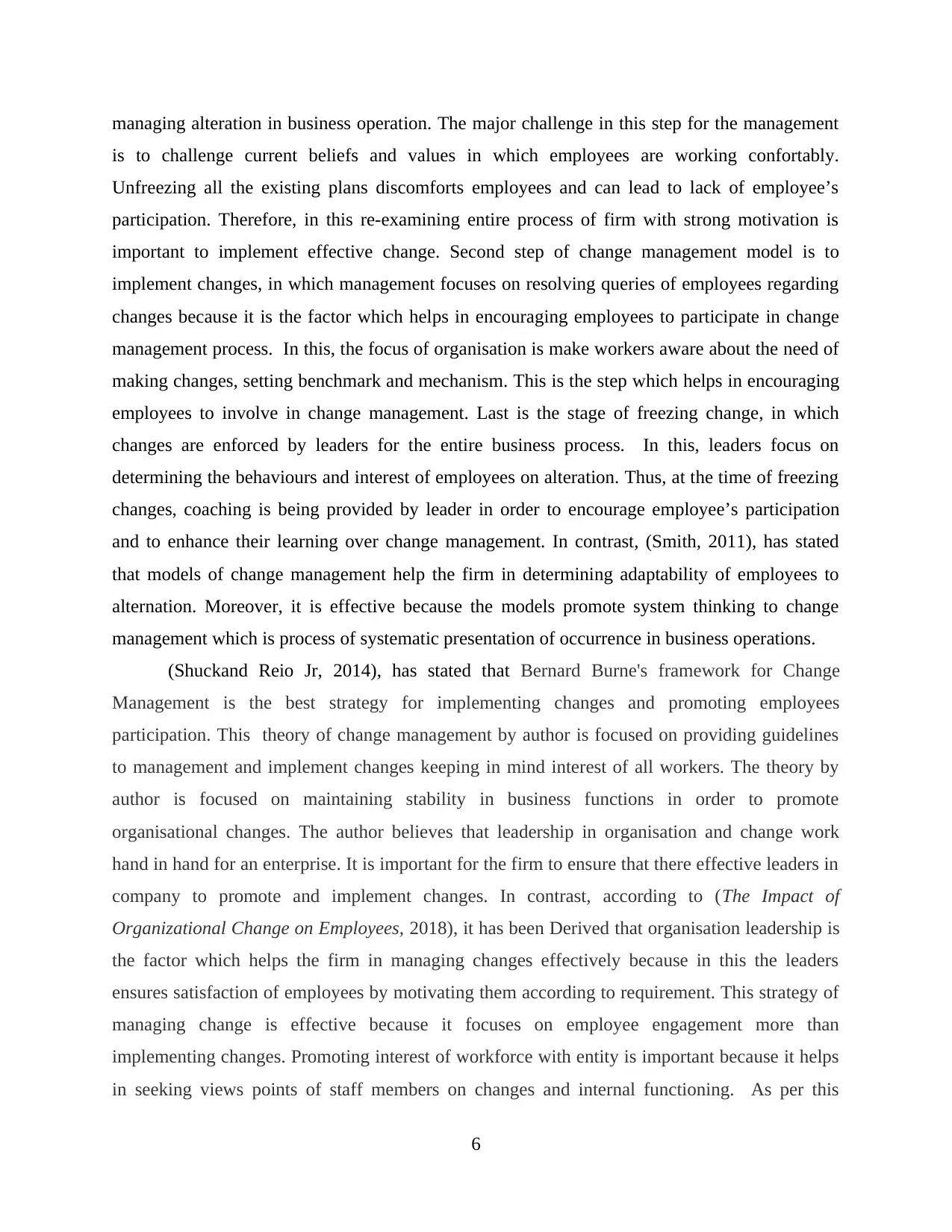
managing alteration in business operation. The major challenge in this step for the management
is to challenge current beliefs and values in which employees are working confortably.
Unfreezing all the existing plans discomforts employees and can lead to lack of employee’s
participation. Therefore, in this re-examining entire process of firm with strong motivation is
important to implement effective change. Second step of change management model is to
implement changes, in which management focuses on resolving queries of employees regarding
changes because it is the factor which helps in encouraging employees to participate in change
management process. In this, the focus of organisation is make workers aware about the need of
making changes, setting benchmark and mechanism. This is the step which helps in encouraging
employees to involve in change management. Last is the stage of freezing change, in which
changes are enforced by leaders for the entire business process. In this, leaders focus on
determining the behaviours and interest of employees on alteration. Thus, at the time of freezing
changes, coaching is being provided by leader in order to encourage employee’s participation
and to enhance their learning over change management. In contrast, (Smith, 2011), has stated
that models of change management help the firm in determining adaptability of employees to
alternation. Moreover, it is effective because the models promote system thinking to change
management which is process of systematic presentation of occurrence in business operations.
(Shuckand Reio Jr, 2014), has stated that Bernard Burne's framework for Change
Management is the best strategy for implementing changes and promoting employees
participation. This theory of change management by author is focused on providing guidelines
to management and implement changes keeping in mind interest of all workers. The theory by
author is focused on maintaining stability in business functions in order to promote
organisational changes. The author believes that leadership in organisation and change work
hand in hand for an enterprise. It is important for the firm to ensure that there effective leaders in
company to promote and implement changes. In contrast, according to (The Impact of
Organizational Change on Employees, 2018), it has been Derived that organisation leadership is
the factor which helps the firm in managing changes effectively because in this the leaders
ensures satisfaction of employees by motivating them according to requirement. This strategy of
managing change is effective because it focuses on employee engagement more than
implementing changes. Promoting interest of workforce with entity is important because it helps
in seeking views points of staff members on changes and internal functioning. As per this
6
is to challenge current beliefs and values in which employees are working confortably.
Unfreezing all the existing plans discomforts employees and can lead to lack of employee’s
participation. Therefore, in this re-examining entire process of firm with strong motivation is
important to implement effective change. Second step of change management model is to
implement changes, in which management focuses on resolving queries of employees regarding
changes because it is the factor which helps in encouraging employees to participate in change
management process. In this, the focus of organisation is make workers aware about the need of
making changes, setting benchmark and mechanism. This is the step which helps in encouraging
employees to involve in change management. Last is the stage of freezing change, in which
changes are enforced by leaders for the entire business process. In this, leaders focus on
determining the behaviours and interest of employees on alteration. Thus, at the time of freezing
changes, coaching is being provided by leader in order to encourage employee’s participation
and to enhance their learning over change management. In contrast, (Smith, 2011), has stated
that models of change management help the firm in determining adaptability of employees to
alternation. Moreover, it is effective because the models promote system thinking to change
management which is process of systematic presentation of occurrence in business operations.
(Shuckand Reio Jr, 2014), has stated that Bernard Burne's framework for Change
Management is the best strategy for implementing changes and promoting employees
participation. This theory of change management by author is focused on providing guidelines
to management and implement changes keeping in mind interest of all workers. The theory by
author is focused on maintaining stability in business functions in order to promote
organisational changes. The author believes that leadership in organisation and change work
hand in hand for an enterprise. It is important for the firm to ensure that there effective leaders in
company to promote and implement changes. In contrast, according to (The Impact of
Organizational Change on Employees, 2018), it has been Derived that organisation leadership is
the factor which helps the firm in managing changes effectively because in this the leaders
ensures satisfaction of employees by motivating them according to requirement. This strategy of
managing change is effective because it focuses on employee engagement more than
implementing changes. Promoting interest of workforce with entity is important because it helps
in seeking views points of staff members on changes and internal functioning. As per this
6
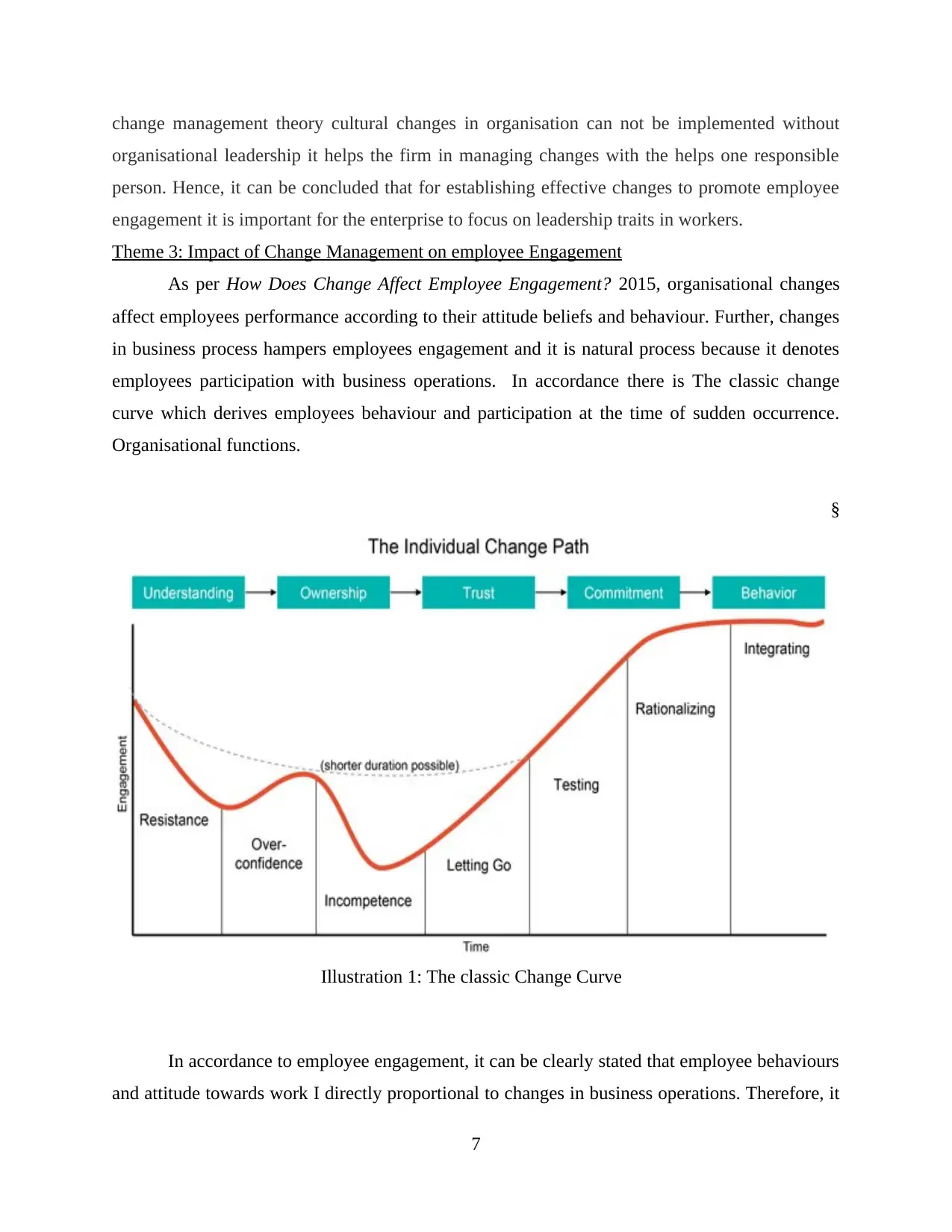
change management theory cultural changes in organisation can not be implemented without
organisational leadership it helps the firm in managing changes with the helps one responsible
person. Hence, it can be concluded that for establishing effective changes to promote employee
engagement it is important for the enterprise to focus on leadership traits in workers.
Theme 3: Impact of Change Management on employee Engagement
As per How Does Change Affect Employee Engagement? 2015, organisational changes
affect employees performance according to their attitude beliefs and behaviour. Further, changes
in business process hampers employees engagement and it is natural process because it denotes
employees participation with business operations. In accordance there is The classic change
curve which derives employees behaviour and participation at the time of sudden occurrence.
Organisational functions.
Illustration 1: The classic Change Curve
§
In accordance to employee engagement, it can be clearly stated that employee behaviours
and attitude towards work I directly proportional to changes in business operations. Therefore, it
7
organisational leadership it helps the firm in managing changes with the helps one responsible
person. Hence, it can be concluded that for establishing effective changes to promote employee
engagement it is important for the enterprise to focus on leadership traits in workers.
Theme 3: Impact of Change Management on employee Engagement
As per How Does Change Affect Employee Engagement? 2015, organisational changes
affect employees performance according to their attitude beliefs and behaviour. Further, changes
in business process hampers employees engagement and it is natural process because it denotes
employees participation with business operations. In accordance there is The classic change
curve which derives employees behaviour and participation at the time of sudden occurrence.
Organisational functions.
Illustration 1: The classic Change Curve
§
In accordance to employee engagement, it can be clearly stated that employee behaviours
and attitude towards work I directly proportional to changes in business operations. Therefore, it
7
⊘ This is a preview!⊘
Do you want full access?
Subscribe today to unlock all pages.

Trusted by 1+ million students worldwide
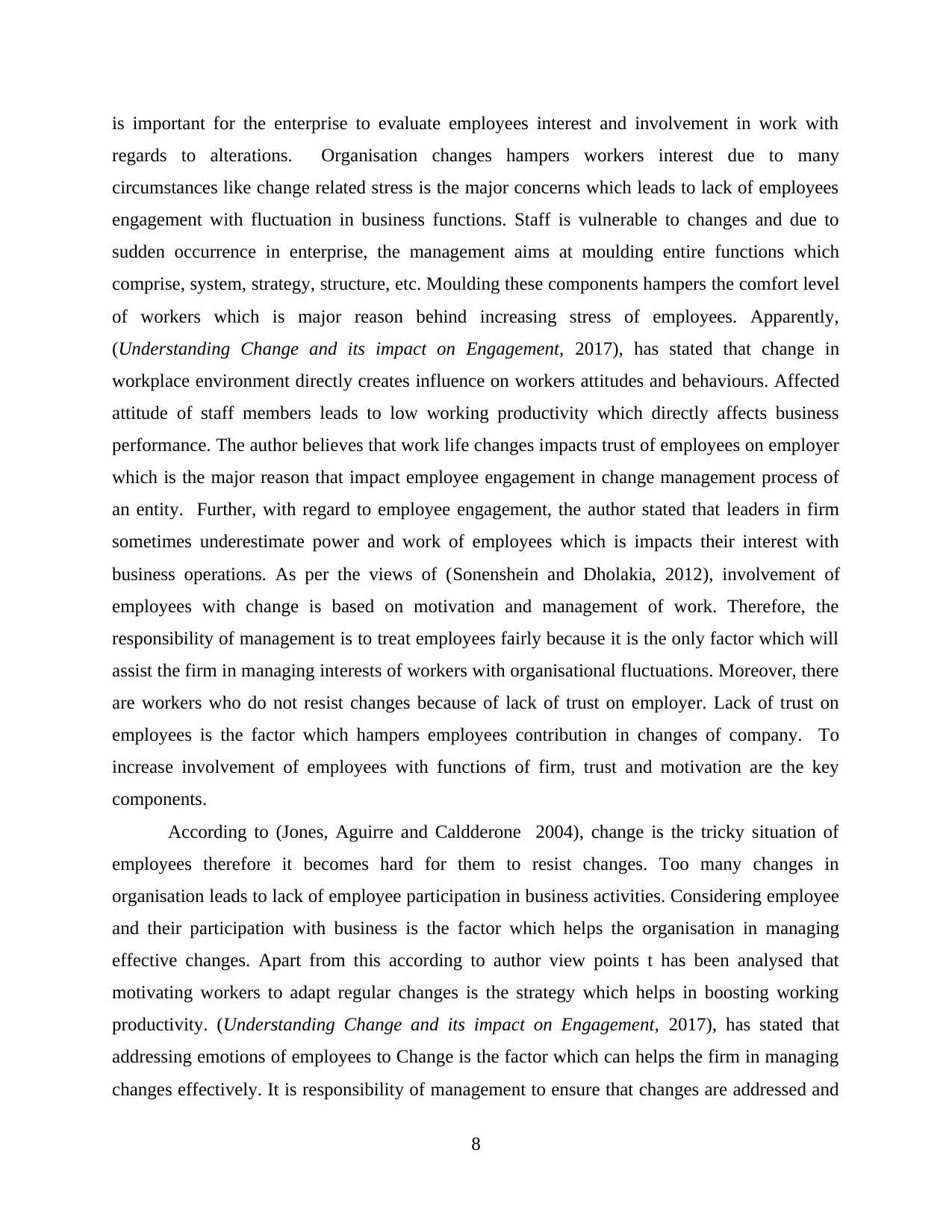
is important for the enterprise to evaluate employees interest and involvement in work with
regards to alterations. Organisation changes hampers workers interest due to many
circumstances like change related stress is the major concerns which leads to lack of employees
engagement with fluctuation in business functions. Staff is vulnerable to changes and due to
sudden occurrence in enterprise, the management aims at moulding entire functions which
comprise, system, strategy, structure, etc. Moulding these components hampers the comfort level
of workers which is major reason behind increasing stress of employees. Apparently,
(Understanding Change and its impact on Engagement, 2017), has stated that change in
workplace environment directly creates influence on workers attitudes and behaviours. Affected
attitude of staff members leads to low working productivity which directly affects business
performance. The author believes that work life changes impacts trust of employees on employer
which is the major reason that impact employee engagement in change management process of
an entity. Further, with regard to employee engagement, the author stated that leaders in firm
sometimes underestimate power and work of employees which is impacts their interest with
business operations. As per the views of (Sonenshein and Dholakia, 2012), involvement of
employees with change is based on motivation and management of work. Therefore, the
responsibility of management is to treat employees fairly because it is the only factor which will
assist the firm in managing interests of workers with organisational fluctuations. Moreover, there
are workers who do not resist changes because of lack of trust on employer. Lack of trust on
employees is the factor which hampers employees contribution in changes of company. To
increase involvement of employees with functions of firm, trust and motivation are the key
components.
According to (Jones, Aguirre and Caldderone 2004), change is the tricky situation of
employees therefore it becomes hard for them to resist changes. Too many changes in
organisation leads to lack of employee participation in business activities. Considering employee
and their participation with business is the factor which helps the organisation in managing
effective changes. Apart from this according to author view points t has been analysed that
motivating workers to adapt regular changes is the strategy which helps in boosting working
productivity. (Understanding Change and its impact on Engagement, 2017), has stated that
addressing emotions of employees to Change is the factor which can helps the firm in managing
changes effectively. It is responsibility of management to ensure that changes are addressed and
8
regards to alterations. Organisation changes hampers workers interest due to many
circumstances like change related stress is the major concerns which leads to lack of employees
engagement with fluctuation in business functions. Staff is vulnerable to changes and due to
sudden occurrence in enterprise, the management aims at moulding entire functions which
comprise, system, strategy, structure, etc. Moulding these components hampers the comfort level
of workers which is major reason behind increasing stress of employees. Apparently,
(Understanding Change and its impact on Engagement, 2017), has stated that change in
workplace environment directly creates influence on workers attitudes and behaviours. Affected
attitude of staff members leads to low working productivity which directly affects business
performance. The author believes that work life changes impacts trust of employees on employer
which is the major reason that impact employee engagement in change management process of
an entity. Further, with regard to employee engagement, the author stated that leaders in firm
sometimes underestimate power and work of employees which is impacts their interest with
business operations. As per the views of (Sonenshein and Dholakia, 2012), involvement of
employees with change is based on motivation and management of work. Therefore, the
responsibility of management is to treat employees fairly because it is the only factor which will
assist the firm in managing interests of workers with organisational fluctuations. Moreover, there
are workers who do not resist changes because of lack of trust on employer. Lack of trust on
employees is the factor which hampers employees contribution in changes of company. To
increase involvement of employees with functions of firm, trust and motivation are the key
components.
According to (Jones, Aguirre and Caldderone 2004), change is the tricky situation of
employees therefore it becomes hard for them to resist changes. Too many changes in
organisation leads to lack of employee participation in business activities. Considering employee
and their participation with business is the factor which helps the organisation in managing
effective changes. Apart from this according to author view points t has been analysed that
motivating workers to adapt regular changes is the strategy which helps in boosting working
productivity. (Understanding Change and its impact on Engagement, 2017), has stated that
addressing emotions of employees to Change is the factor which can helps the firm in managing
changes effectively. It is responsibility of management to ensure that changes are addressed and
8
Paraphrase This Document
Need a fresh take? Get an instant paraphrase of this document with our AI Paraphraser
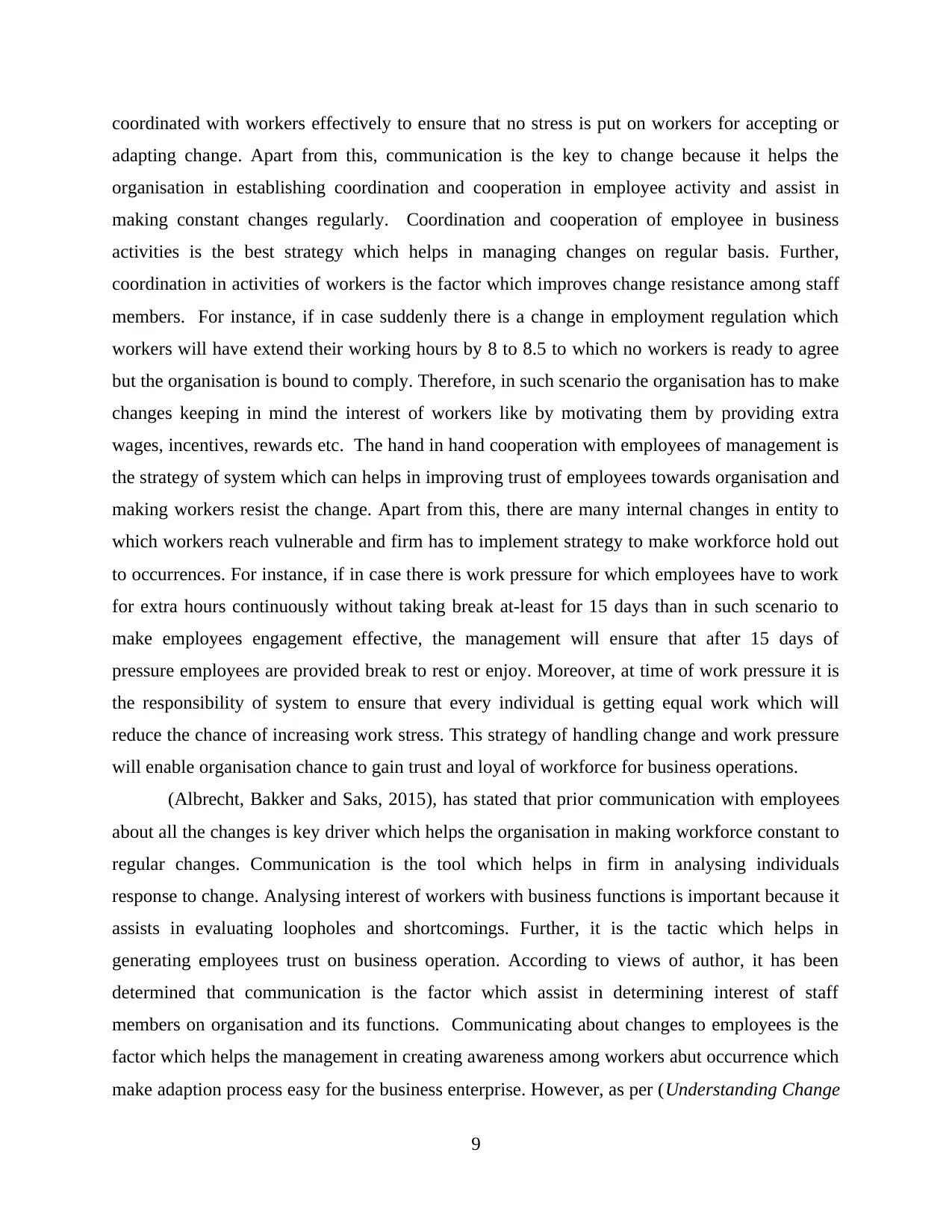
coordinated with workers effectively to ensure that no stress is put on workers for accepting or
adapting change. Apart from this, communication is the key to change because it helps the
organisation in establishing coordination and cooperation in employee activity and assist in
making constant changes regularly. Coordination and cooperation of employee in business
activities is the best strategy which helps in managing changes on regular basis. Further,
coordination in activities of workers is the factor which improves change resistance among staff
members. For instance, if in case suddenly there is a change in employment regulation which
workers will have extend their working hours by 8 to 8.5 to which no workers is ready to agree
but the organisation is bound to comply. Therefore, in such scenario the organisation has to make
changes keeping in mind the interest of workers like by motivating them by providing extra
wages, incentives, rewards etc. The hand in hand cooperation with employees of management is
the strategy of system which can helps in improving trust of employees towards organisation and
making workers resist the change. Apart from this, there are many internal changes in entity to
which workers reach vulnerable and firm has to implement strategy to make workforce hold out
to occurrences. For instance, if in case there is work pressure for which employees have to work
for extra hours continuously without taking break at-least for 15 days than in such scenario to
make employees engagement effective, the management will ensure that after 15 days of
pressure employees are provided break to rest or enjoy. Moreover, at time of work pressure it is
the responsibility of system to ensure that every individual is getting equal work which will
reduce the chance of increasing work stress. This strategy of handling change and work pressure
will enable organisation chance to gain trust and loyal of workforce for business operations.
(Albrecht, Bakker and Saks, 2015), has stated that prior communication with employees
about all the changes is key driver which helps the organisation in making workforce constant to
regular changes. Communication is the tool which helps in firm in analysing individuals
response to change. Analysing interest of workers with business functions is important because it
assists in evaluating loopholes and shortcomings. Further, it is the tactic which helps in
generating employees trust on business operation. According to views of author, it has been
determined that communication is the factor which assist in determining interest of staff
members on organisation and its functions. Communicating about changes to employees is the
factor which helps the management in creating awareness among workers abut occurrence which
make adaption process easy for the business enterprise. However, as per (Understanding Change
9
adapting change. Apart from this, communication is the key to change because it helps the
organisation in establishing coordination and cooperation in employee activity and assist in
making constant changes regularly. Coordination and cooperation of employee in business
activities is the best strategy which helps in managing changes on regular basis. Further,
coordination in activities of workers is the factor which improves change resistance among staff
members. For instance, if in case suddenly there is a change in employment regulation which
workers will have extend their working hours by 8 to 8.5 to which no workers is ready to agree
but the organisation is bound to comply. Therefore, in such scenario the organisation has to make
changes keeping in mind the interest of workers like by motivating them by providing extra
wages, incentives, rewards etc. The hand in hand cooperation with employees of management is
the strategy of system which can helps in improving trust of employees towards organisation and
making workers resist the change. Apart from this, there are many internal changes in entity to
which workers reach vulnerable and firm has to implement strategy to make workforce hold out
to occurrences. For instance, if in case there is work pressure for which employees have to work
for extra hours continuously without taking break at-least for 15 days than in such scenario to
make employees engagement effective, the management will ensure that after 15 days of
pressure employees are provided break to rest or enjoy. Moreover, at time of work pressure it is
the responsibility of system to ensure that every individual is getting equal work which will
reduce the chance of increasing work stress. This strategy of handling change and work pressure
will enable organisation chance to gain trust and loyal of workforce for business operations.
(Albrecht, Bakker and Saks, 2015), has stated that prior communication with employees
about all the changes is key driver which helps the organisation in making workforce constant to
regular changes. Communication is the tool which helps in firm in analysing individuals
response to change. Analysing interest of workers with business functions is important because it
assists in evaluating loopholes and shortcomings. Further, it is the tactic which helps in
generating employees trust on business operation. According to views of author, it has been
determined that communication is the factor which assist in determining interest of staff
members on organisation and its functions. Communicating about changes to employees is the
factor which helps the management in creating awareness among workers abut occurrence which
make adaption process easy for the business enterprise. However, as per (Understanding Change
9
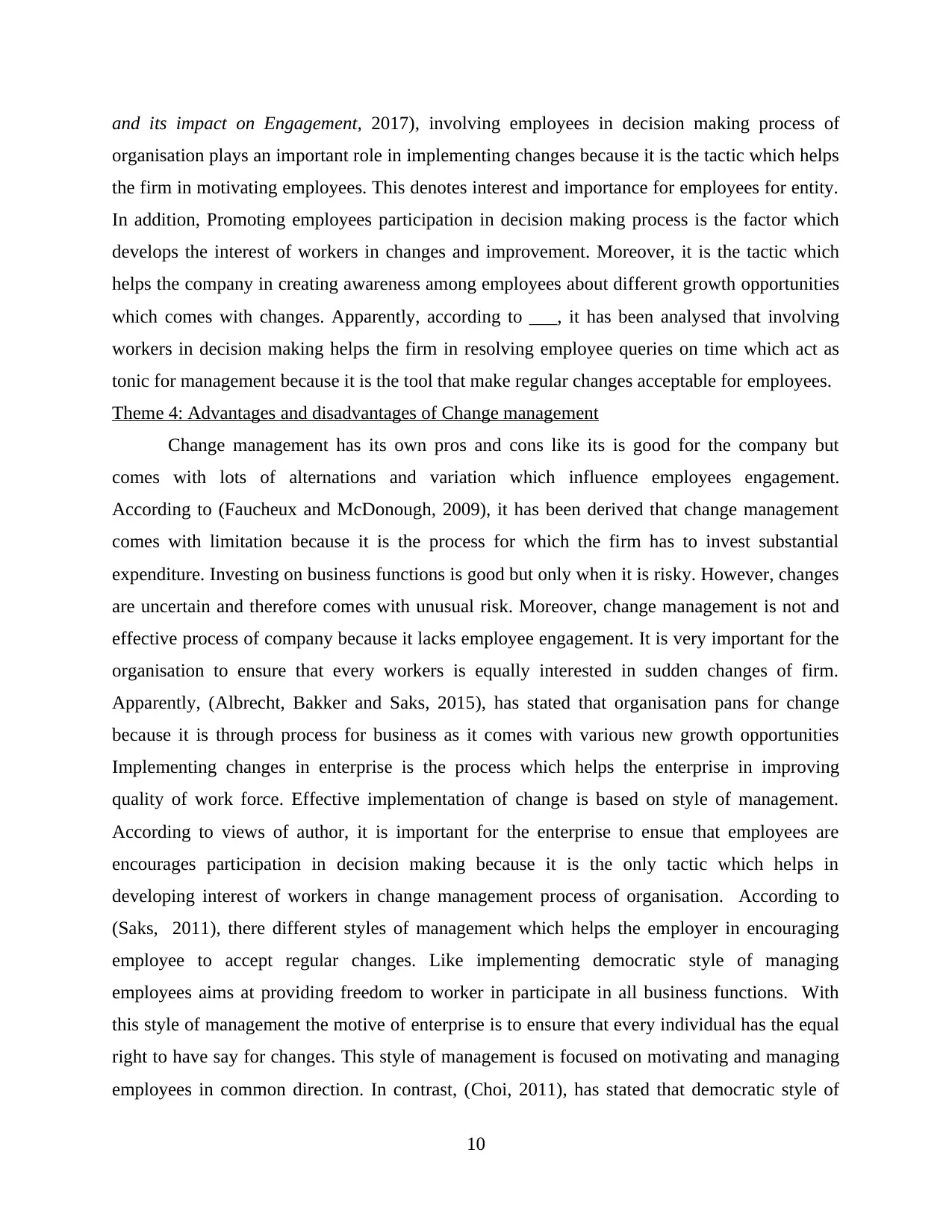
and its impact on Engagement, 2017), involving employees in decision making process of
organisation plays an important role in implementing changes because it is the tactic which helps
the firm in motivating employees. This denotes interest and importance for employees for entity.
In addition, Promoting employees participation in decision making process is the factor which
develops the interest of workers in changes and improvement. Moreover, it is the tactic which
helps the company in creating awareness among employees about different growth opportunities
which comes with changes. Apparently, according to ___, it has been analysed that involving
workers in decision making helps the firm in resolving employee queries on time which act as
tonic for management because it is the tool that make regular changes acceptable for employees.
Theme 4: Advantages and disadvantages of Change management
Change management has its own pros and cons like its is good for the company but
comes with lots of alternations and variation which influence employees engagement.
According to (Faucheux and McDonough, 2009), it has been derived that change management
comes with limitation because it is the process for which the firm has to invest substantial
expenditure. Investing on business functions is good but only when it is risky. However, changes
are uncertain and therefore comes with unusual risk. Moreover, change management is not and
effective process of company because it lacks employee engagement. It is very important for the
organisation to ensure that every workers is equally interested in sudden changes of firm.
Apparently, (Albrecht, Bakker and Saks, 2015), has stated that organisation pans for change
because it is through process for business as it comes with various new growth opportunities
Implementing changes in enterprise is the process which helps the enterprise in improving
quality of work force. Effective implementation of change is based on style of management.
According to views of author, it is important for the enterprise to ensue that employees are
encourages participation in decision making because it is the only tactic which helps in
developing interest of workers in change management process of organisation. According to
(Saks, 2011), there different styles of management which helps the employer in encouraging
employee to accept regular changes. Like implementing democratic style of managing
employees aims at providing freedom to worker in participate in all business functions. With
this style of management the motive of enterprise is to ensure that every individual has the equal
right to have say for changes. This style of management is focused on motivating and managing
employees in common direction. In contrast, (Choi, 2011), has stated that democratic style of
10
organisation plays an important role in implementing changes because it is the tactic which helps
the firm in motivating employees. This denotes interest and importance for employees for entity.
In addition, Promoting employees participation in decision making process is the factor which
develops the interest of workers in changes and improvement. Moreover, it is the tactic which
helps the company in creating awareness among employees about different growth opportunities
which comes with changes. Apparently, according to ___, it has been analysed that involving
workers in decision making helps the firm in resolving employee queries on time which act as
tonic for management because it is the tool that make regular changes acceptable for employees.
Theme 4: Advantages and disadvantages of Change management
Change management has its own pros and cons like its is good for the company but
comes with lots of alternations and variation which influence employees engagement.
According to (Faucheux and McDonough, 2009), it has been derived that change management
comes with limitation because it is the process for which the firm has to invest substantial
expenditure. Investing on business functions is good but only when it is risky. However, changes
are uncertain and therefore comes with unusual risk. Moreover, change management is not and
effective process of company because it lacks employee engagement. It is very important for the
organisation to ensure that every workers is equally interested in sudden changes of firm.
Apparently, (Albrecht, Bakker and Saks, 2015), has stated that organisation pans for change
because it is through process for business as it comes with various new growth opportunities
Implementing changes in enterprise is the process which helps the enterprise in improving
quality of work force. Effective implementation of change is based on style of management.
According to views of author, it is important for the enterprise to ensue that employees are
encourages participation in decision making because it is the only tactic which helps in
developing interest of workers in change management process of organisation. According to
(Saks, 2011), there different styles of management which helps the employer in encouraging
employee to accept regular changes. Like implementing democratic style of managing
employees aims at providing freedom to worker in participate in all business functions. With
this style of management the motive of enterprise is to ensure that every individual has the equal
right to have say for changes. This style of management is focused on motivating and managing
employees in common direction. In contrast, (Choi, 2011), has stated that democratic style of
10
⊘ This is a preview!⊘
Do you want full access?
Subscribe today to unlock all pages.

Trusted by 1+ million students worldwide
1 out of 18
Related Documents
Your All-in-One AI-Powered Toolkit for Academic Success.
+13062052269
info@desklib.com
Available 24*7 on WhatsApp / Email
![[object Object]](/_next/static/media/star-bottom.7253800d.svg)
Unlock your academic potential
Copyright © 2020–2025 A2Z Services. All Rights Reserved. Developed and managed by ZUCOL.




